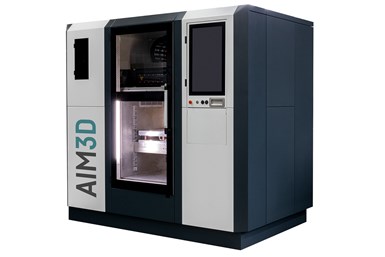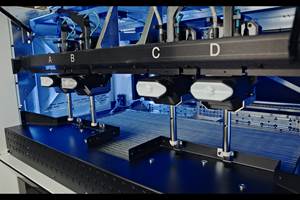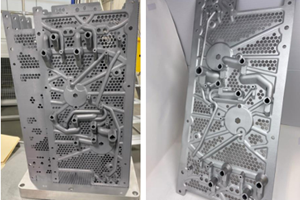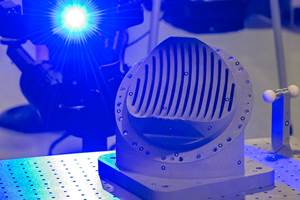AIM3D Study Shows 3D Printing Ultem 9085 Pellets Offers Lower Cost, Higher Tensile Strength
The material qualification testing indicates many benefits of creating components with AIM3D’s ExAM 510 printer using the composite extrusion modeling process, which uses standard pellets rather than the more expensive filaments required by other platforms.
AIM3D says its material qualification testing of Sabic’s Ultem 9085 resin granulate for its ExAM 510 3D printer using its composite extrusion modeling (CEM) process with standard pellets showed a variety of benefits compared to using filament 3D printers. The advantages include lower material costs, faster build speeds, improved reproducibility and high tensile strengths, which can open up new fields of application for using 3D pellet printing of Ultem without filaments.
As part of the material qualification process, AIM3D analyzed the properties of a component printed using Ultem 9085 resin on its ExAM 510 3D printer to unlock its use in pellet 3D printing. The company’s CEM process uses standard pellets and thus offers a high potential of economic efficiency and higher build speeds compared to filament 3D printers.
The objective was to take advantage of the significantly lower material costs when using standard granulates compared to using conventional filament materials, which are said to be reduced by up to a factor of seven. The development focused on high-performance applications in the aerospace sector.
Sabic’s Ultem 9085 resin is a certified material in the aerospace industry (FAR 25.853, Blue Card and UL 94 V-0) with special fire safety qualities. As a member of the polyetherimide (PEI) family, it is a high-temperature material with excellent physical and mechanical properties for demanding applications. Due to its strength-to-weight ratio, Ultem is considered an ideal thermoplastic for applications that require high strengths and a low weight.
In general, Ultem 9085 resin also exhibits a high impact strength and very good chemical tolerance, showing very good flammability, smoke and toxicity properties. Sabic supplies Ultem 9085 resin in many different colors and can be customized to any color requirements.
The results of tensile strength testing indicate comparable results with injection molding and much better results than filament 3D printing. It was also found that the elongation at break of the specimens printed using granulates provided significantly better results — 12.3% elongation at break could be achieved in the XY direction, while filament 3D printing only reaches 5.4%.
Testing also indicates improved reproducibility with a 3D pellet printer. Components created using both injection molding technology and 3D pellet printing exhibited comparable homogeneities of the material due to the use of Ultem 9085 resin granulates. The latest tensile tests according to DIN EN ISO 527-2 type 1A presented low standard deviations and prove the high stability of the process.
Pellet printing offers significantly faster time-to-market, both for prototypes and for series components. AIM3D’s extruders and technology also achieve better surface qualities with the same build time. This is possible because the use of granulates enables higher build rates to be achieved even with lower layer thicknesses.
“The use of a pellet 3D printer will not only make existing applications more cost-effective in the future,” says Dr. Vincent Morrison, AIM3D CEO. “In fact, we will see a much wider application of Ultem 9085 resin in the future, with fields of application that simply were not economical in the past. Especially in the aerospace sector, this will open up new horizons.”
- Read about the research partners that 3D printed a MIM tool with near-contour cooling. The basis of the project was the use of AIM3D’s CEM technology with an ExAM 255 system, which is an all-in-one, multimaterial 3D printer for AM of metals, plastics and ceramics.
Related Content
Stratasys Partners With NOCTI for First-Ever FDM Process Certification
The recognition from NOCTI marks a significant step toward strengthening education and building competent workforces in the field of additive manufacturing.
Read MoreVelo3D Founder on the 3 Biggest Challenges of 3D Printing Metal Parts
Velo3D CEO and founder Benny Buller offers this perspective on cost, qualification and ease of development as they apply to the progress of AM adoption in the future.
Read MoreAdditive Manufacturing in Transportation: How It Moves Us
Transportation is experiencing unprecedented pressure to move people and goods farther, faster, cheaper and more sustainably. The Barnes Global Advisors and Wabtec discuss the role that additive manufacturing is playing for rail transportation, and how 3D printed parts such as manifolds are qualified for this industry.
Read MoreAdditive Manufacturing in Space: Failing Upward
Not all 3D printed parts destined for space need to adhere to the standards of human space flight. Yet all parts made for space programs require some type of qualification and certification. NASA and The Barnes Global Advisors explore Q&C for these parts.
Read MoreRead Next
3D Printing Brings Sustainability, Accessibility to Glass Manufacturing
Australian startup Maple Glass Printing has developed a process for extruding glass into artwork, lab implements and architectural elements. Along the way, the company has also found more efficient ways of recycling this material.
Read MoreAt General Atomics, Do Unmanned Aerial Systems Reveal the Future of Aircraft Manufacturing?
The maker of the Predator and SkyGuardian remote aircraft can implement additive manufacturing more rapidly and widely than the makers of other types of planes. The role of 3D printing in current and future UAS components hints at how far AM can go to save cost and time in aircraft production and design.
Read More4 Ways the Education and Training Challenge Is Different for Additive Manufacturing
The advance of additive manufacturing means we need more professionals educated in AM technology.
Read More























